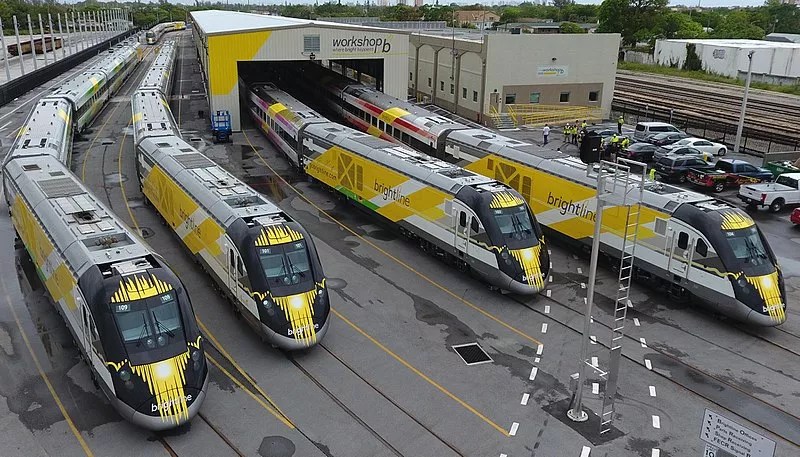
Photo by Patrick Hamilton

Audio By Carbonatix
Trains will be zipping through Palm Beach County at 110 miles per hour this weekend during a test of Brightline’s high-speed rail expansion, as the company faces scrutiny over whether its safety upgrades will stem a tide of fatal accidents around one of the deadliest railway corridors in the nation.
The high-speed testing will begin on Saturday, February 11, from 7 a.m. to 4 p.m. and last through March in Jupiter, Palm Beach Gardens, North Palm Beach, Lake Park, Riviera Beach, and West Palm Beach.
Trial runs on sections of Brightline’s planned rail service expansion to Orlando began last fall in Martin and St. Lucie counties and will continue in the coming months on the new 129-mile stretch of railroad between West Palm Beach and Cocoa.
Brightline trains traveling at a maximum speed of 79 miles per hour have accounted for dozens of deaths since the rail service’s inception five years ago. An early 2022 review by the Associated Press found Brightline’s trains average approximately one fatality every 35,000 miles traveled, which is “three times worse than the next mid-size or major railroad.”
New Times‘ chronicle of Brightline fatal accidents shows that last year, the majority of the more than 20 deaths involved pedestrians, several of whom died in confirmed or suspected suicides. At least five fatal incidents involved vehicles driving onto the tracks.
The company said in a news release that flaggers will be along the railroad crossings this weekend, where trains will be tested at high speeds.
“Residents should be alert and follow the law around active railroad tracks and railroad crossings,” the release said. Testing is expected to bring additional wait times at railroad crossings.
Roadway safety advocate Mike Arias tells New Times the increase in speeds in the northern section of the corridor would be most concerning if trains do not sharply reduce velocity at crossings, especially in densely populated areas. Arias contends many Brightline accidents could be prevented “if the trains would simply slow down as they are approaching the crossing.”
“They can speed up once again to the next intersection cross, and if they lose a minute or two by slowing down, they can make that up in the non-populated rural areas… There would be no additional time incurred,” suggests Arias, a retired traffic officer for Miami-Dade Fire Rescue.
Brightline says it has been installing new safety improvements at all 156 railroad crossings.
The company claims the crossings in the testing area along the north end of the track have already-completed upgrades, including crossing gates, signal systems, pedestrian gates, pavement markings, and roadway profiles. In areas where trains will be traveling more than 79 miles per hour, crossings have four-gate safety systems or medians to prevent motorists from driving across the tracks when trains are approaching.
In August, the company announced a $45 million federally funded project to improve safety along the Brightline and Florida East Coast Railway corridor.
Issued under the Rebuilding American Infrastructure with Sustainability and Equity program, the grant will provide for the construction of “at least 33 miles of pedestrian protection features and supplemental safety measures.” Brightline claims the grant will fund fencing, better safety signage, and raised pavement markers, among other upgrades stretching from Brevard to Miami-Dade counties.
Arias says the recently announced improvements should have been in place since day one. He says he was just in downtown Hollywood when he noticed a railway crossing with inadequate safety barriers to prevent pedestrians from freely walking across while a train approaches.
He maintains the simplest way to improve safety is to reduce train speed in metropolitan areas.
“I don’t know why they’re dead set on not wanting to slow down,” Arias says.
The ride from Miami Central Station to Orlando International Airport is expected to take about three hours with trains traveling up to 125 miles per hour. The train service, which currently runs from West Palm Beach to Miami, recently opened stations in Aventura and Boca Raton, bringing the total number of stops to five.